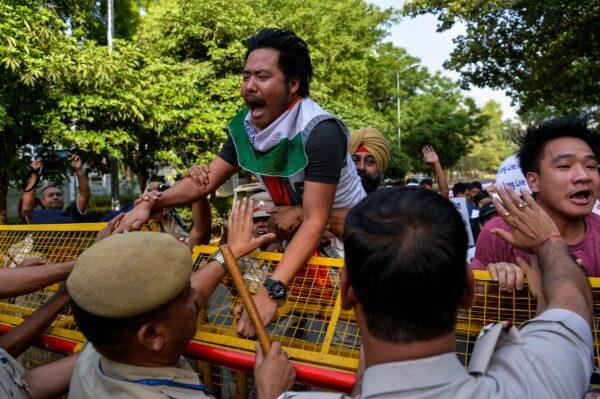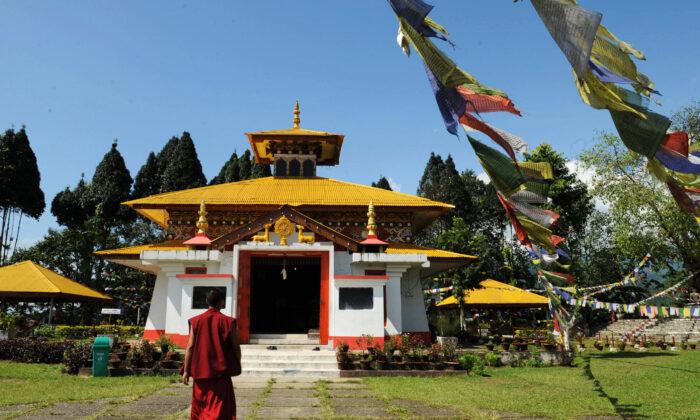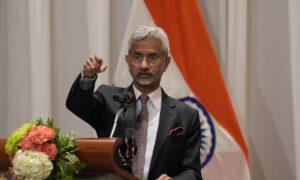NEW DELHI–Days after China reiterated its claim to the Indian territory of Arunachal Pradesh in India’s eastern Himalayan sector, the United States voiced strong opposition to the claim. The exchange came as Beijing once again revised its maps of the region, christening dozens of places in the Indian state with new Chinese names.
“The United States recognizes Arunachal Pradesh as Indian territory, and we strongly oppose any unilateral attempts to advance territorial claims by incursions or encroachments, military or civilian, across the Line of Actual Control,” U.S. State Department spokesperson Vedant Patel said in response to a question during daily news briefings on March 20.
Arunachal Pradesh is a Himalayan Indian territory, adjacent to Bhutan and on the border with Burma (also known as Myanmar). It is an important seat of Tibetan Buddhism, home to many important monasteries—including some that were established hundreds of years ago. It shares more than 700 miles of disputed border with Tibet, which is ruled by China as the Tibet Autonomous Region.
Frank Lehberger is a Europe-based Sinologist with 25 years of experience working in China and Tibet. An expert in the cartography of the Eastern Himalayan sector, which includes Arunachal Pradesh, he told The Epoch Times via email that the U.S. statement is a clear signal to China that the United States will back India diplomatically, legally, and militarily.
“The recent statement is complementary to what was stated last year, also signaling Washington’s position that Arunachal Pradesh is not so-called ‘contested territory,’ but confirming that it is clearly an integral part of India,” Mr. Lehberger said.
The U.S. statement also sends a signal to public opinion in India that the United States can provide much more dependable support against China than Putin’s Russia, he said.
The U.S. statement came a few days after the Chinese defense ministry restated its claim over Arunachal Pradesh on March 15, with Chinese defense ministry spokesperson Zhang Xiaogang, who holds the rank of senior colonel, calling India’s administration of the region illegal.
“Zangnan is China’s inherent territory, and China never recognizes and firmly opposes India’s illegal establishment of the so-called ‘Arunachal Pradesh,'” he said.
Claude Arpi, a French-born Tibetologist, historian, and author who currently lives in India, told The Epoch Times in an email that the United States has its own reasons for supporting India’s claim.
China Condemns US Interference
Meanwhile, China has criticized the U.S. statement on Arunachal Pradesh, calling it interference in India’s and China’s border disputes. Chinese foreign ministry spokesperson Lin Jian criticized the U.S. stance during a news conference in Beijing on March 21. Mr. Lin said the issue is a bilateral matter and is not subject to U.S. involvement.Raviprasad Narayanan, professor at the Centre for East Asian Studies at New Delhi’s Jawaharlal Nehru University, told The Epoch Times that the United States wants to involve itself in an eventual settlement of the border dispute between India and China.
“They feel that if China has to be checked, first they have to be told that Arunachal Pradesh does not belong to them and they cannot keep claiming it and renaming places in Arunachal. The U.S. is worried more about China’s economic investments in Tibet,” said Mr. Narayanan, who has lived and worked in both China and Taiwan.
He cited U.S. concerns about newly constructed structures in Arunachal Pradesh. The Chinese say they’re homes; however, they are seen as dual-use residences for the People’s Liberation Army, built with future conflict in mind. In this context, Arunachal Pradesh is strategically important because of its long border with Tibet, where the Chinese have massively invested in infrastructure and information networks.
Mr. Narayanan also said that as chairman of China’s Central Military Commission, Chinese leader Xi Jinping is the paramount decision-maker on defense matters in China. He said Xi is using the border situation with India, particularly the disputes in Arunachal Pradesh and Ladakh, as an opportunity to reinforce his leadership and most likely prepare for an unprecedented fourth term.
In a domestic political context, aggressive messaging on the border issue is a response to factional tussles within the Chinese Communist Party (CCP). Certain factions within the party have tried to constrain Xi, although Mr. Narayanan claims that he is still the leader of a loyal faction.
He said Xi appears to be struggling to connect with the cadre on multiple issues facing the country. “His book titled ‘Selected Works of Xi Jinping’ [is a] compilation of speeches made with no theoretical innovations, and more akin to a factory manager speaking about increases in productivity and manufacturing to be reached,” Mr. Narayanan said.

No Historical Basis for Chinese Claim
While China annexed Tibet under Mao Zedong’s leadership in 1951—just a few years after India gained independence in 1947—its claim to Arunachal Pradesh arose only recently.In 2006, a Chinese envoy stated that the whole of Arunachal Pradesh was a part of China. China now shows the northeastern Indian state as Chinese territory on its maps. In 2017, 2021, and 2023, it renamed places in the region, claiming that it has been a part of China since ancient times.
On April 1, China released another set of 30 renamed locations in the Indian state—the fourth time that it has changed Arunachal Pradesh’s place names on Chinese maps. The renaming drew a strong rejection from the Indian government.
“First, it has to be mentioned that this claim for ‘Southern Tibet’ as part of China is very recent and it has no historical or ethnic basis; it is a pure fabrication to bargain somewhere else on the border,” Mr. Arpi said.
“The legal basis for the McMahon Line being India’s legal border are the border maps drawn during the 1914 Simla Convention, and signed by the governments of British India and Tibet. The Republic of India is the legal successor of British India,” Mr. Lehberger said. Those maps are very specific, he said, and are bilingual in both Tibetan and English, but not in Chinese.
A diplomatic delegation from the Republic of China—which was in power from 1912 to 1949, when the CCP proclaimed the People’s Republic of China—was present at the Simla Convention. Although it negotiated with the other parties, in the end it did not sign the treaty.
“To the present day, all Chinese governments ... have repudiated the Simla Convention and have declared it as null and void,” Mr. Lehberger said.
According to Mr. Arpi, in 1955, then-Chinese premier Zhou Enlai told India’s first prime minister, Jawaharlal Nehru, that he had no quarrel with the McMahon Line as such—except for its “colonial” name, McMahon.
However, “today, China claims a large chunk of India’s territory south of the line,” Mr. Arpi said.

A Pattern of Behavior
Experts have told The Epoch Times that India is not the only country facing such Chinese aggression. Other countries in China’s neighborhood face similar Chinese tactics. It’s high time that these countries counter Chinese expansionism together, they say.“It is not uncommon for China to rename or restore original names to disputed territories or territorial waters. For example, it has similar practices in the East China Sea and South China Sea,” Shen Ming-Shih, director of the division of national security research and acting deputy CEO at Taiwan’s Institute for National Defense and Security Research, said.
“Its main purpose is to highlight China’s sovereignty over these territories or territorial waters, create territorial disputes, and serve as the basis for future legal warfare. But more importantly, it can declare internally the tough attitude of Xi Jinping or the military toward the maintenance of territorial sovereignty,” Mr. Shen told The Epoch Times in an email.
With unilateral statements and illegal acts such as renaming places and topographical features in Arunachal Pradesh, the CCP intends to deflect internal Chinese criticism from itself and “whip up a jingoist and xenophobic mood” among the Chinese populace, Mr. Lehberger said.
“Coinciding with the NPC [National People’s Conference] in Beijing, China has made a series of stridently nationalistic and revisionist noises in the entire Indo-Pacific, namely in the South China Sea with the Philippines, on the Taiwan outlying islands near the Chinese coast and [in] Arunachal Pradesh,” he said.
Water Wars
Arunachal Pradesh is also extremely important because of its location in the transboundary river basin of the Yarlung Zangpo. The river is called the Siang/Dihang in Arunachal, the Brahmaputra in eastern India, and the Jamuna in Bangladesh. Thus the Brahmaputra valley is a trilateral issue, according to Mr. Narayanan.Arunachal becomes more important in the context of this transboundary river dispute because many important tributaries join the Brahmaputra inside Arunachal on Tibet’s border. According to Mr. Narayanan, China is building a new dam on the Yarlung Zangpo in Tibet that will be three times larger than the Three Gorges Dam, the world’s largest hydroelectric facility.
“[The new dam] will make the whole region unstable when it comes to the fragile geography [of the region]. The weight of the water from the reservoir is going to influence earthquakes in the larger trans-border region,” Mr. Narayanan said, adding that Arunachal Pradesh could end up becoming a geo-strategic theater of water wars in the region—one reason behind China’s actions.
It’s time for collective action, Mr. Shen said. If one country is weak in countering Chinese expansionism, China will push forward even more, he said.
“Whether it is Japan, Taiwan, the Philippines, or India, they should bravely face territorial and sea disputes with China. In addition to seeking legal legitimacy through international law, they must also strengthen military preparations and international cooperation to effectively deter China’s territorial expansion,” Mr. Shen said.







